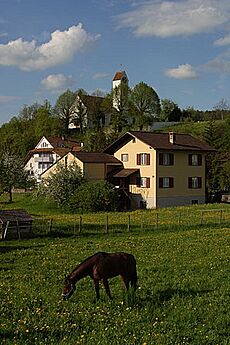Diegten facts for kids
Quick facts for kids
Diegten
|
||
|---|---|---|
 |
||
|
||
| Country | Switzerland | |
| Canton | Basel-Landschaft | |
| District | Waldenburg | |
| Area | ||
| • Total | 9.64 km2 (3.72 sq mi) | |
| Elevation | 469 m (1,539 ft) | |
| Population
(Jun 2021 )
|
||
| • Total | 1,638 | |
| • Density | 169.92/km2 (440.1/sq mi) | |
| Postal code |
4457
|
|
| Surrounded by | Bennwil, Eptingen, Hölstein, Känerkinden, Läufelfingen, Tenniken, Wittinsburg | |
Diegten is a small town, also called a municipality, located in the Waldenburg district. It is part of the canton of Basel-Country in Switzerland. It's a great place to learn about Swiss history and how communities grow.
Contents
History of Diegten
Diegten has a long history, with its name changing over many years. The first time Diegten was officially written down was in 1152. Back then, it was called Dietingoven.
Later, in 1213, people referred to it as Dietikon. By 1342, the name had changed again to Dietken. Finally, in 1671, it became known as Dieckten, which is very close to its modern name, Diegten.
Exploring Diegten's Geography
Diegten covers an area of about 9.64 square kilometers (about 3.7 square miles). That's roughly the size of 1,300 football fields!
A big part of Diegten's land, almost half (49.5%), is used for farming. Forests cover a large portion too, about 39.5% of the area. The remaining land, about 11.1%, is where buildings and roads are located.
The town is nestled in the Diegter valley within the Waldenburg district. It's quite unique because it's made up of five smaller villages that stretch out in a line for about 2 kilometers (1.2 miles). These villages are Ober-Diegten, Mühle-Diegten, Mittel-Diegten, Schloss-Diegten, and Nieder-Diegten. This type of settlement is called a linear village.
Diegten's Coat of Arms
Every town has a special symbol called a coat of arms. Diegten's coat of arms has two main parts.
On one side, it shows a black lion standing on its hind legs against a gold background. On the other side, it has six stripes that alternate between black and silver. This design is called Per pale, Or a Lion rampant Sable, and Bendy of six Sable and Argent.
Who Lives in Diegten? (Demographics)
as of June 2021[update], Diegten has a population of 1,638 people. About 7.6% of the people living here are from other countries. Over the past ten years (1997–2007), the number of people living in Diegten has grown by 13.7%.
Most people in Diegten speak German, which is 96.3% of the population. A small number of people also speak French or Italian.
As of 2008[update], the population was almost evenly split between males (49.6%) and females (50.4%). Most residents (90.4%) are Swiss citizens, while 9.6% are non-Swiss residents.
Many people living in Diegten were born there (30.1%). Others were born in the same canton (32.4%) or elsewhere in Switzerland (27.2%). About 7.8% of the residents were born outside of Switzerland.
In 2008[update], the population of Swiss citizens slightly decreased by 2, while the number of non-Swiss residents increased by 8. Overall, the population grew by 0.4% that year.
The age groups in Diegten as of 2010[update] show a good mix:
- Children aged 0-6: 6.8%
- Teenagers aged 7-19: 19.5%
- Young adults aged 20-29: 9.9%
- Adults aged 30-49: 32.7%
- Adults aged 50-64: 19.2%
- Seniors aged 65 and over: 11.9%
As of 2000[update], there were 510 households in Diegten, with an average of 2.6 people living in each. About 21.8% of households were made up of just one person. There were also many families, including married couples with and without children, and single parents.
Most of the buildings in Diegten are single-family homes (67.6%). There are also multi-family buildings and buildings used for both homes and businesses. As of 2000[update], there were 540 apartments in the town. Most of these apartments (90.7%) were lived in all the time.
The historical population of Diegten is shown in the chart below:

Diegten's Economy and Jobs
As of 2010[update], Diegten had a low unemployment rate of 2.7%. This means most people who wanted jobs could find them.
The economy of Diegten is divided into three main parts:
- Primary Sector: This includes jobs like farming and forestry. As of 2008[update], 108 people worked in this sector, with 32 businesses.
- Secondary Sector: This involves manufacturing and construction. There were 81 people working in this sector across 18 businesses.
- Tertiary Sector: This covers services like retail, transportation, hotels, education, and healthcare. 206 people worked in this sector, with 34 businesses.
Many people who live in Diegten travel to other towns for work. As of 2000[update], 540 residents commuted out of the municipality, while 149 people came into Diegten for work. About 17.1% of workers used public transportation, and 57% drove their own cars.
Religion in Diegten
As of 2000[update], the main religions in Diegten were:
- Swiss Reformed Church: 64.6% of the population
- Roman Catholic: 16.4% of the population
Smaller groups included members of Orthodox churches, the Christian Catholic Church, and other Christian churches. There were also people who identified as Jewish, Islamic, Buddhist, or Hindu. About 9.42% of the population did not belong to any church.
Education in Diegten
Education is important in Diegten. About 42.7% of the population has completed upper secondary education, which is like high school.
Also, 9.2% of the population has gone on to higher education, either at a university or a specialized college (called a Fachhochschule).
As of 2000[update], 91 students came to Diegten for school from other towns. At the same time, 101 students from Diegten went to schools outside the municipality.
See also
 In Spanish: Diegten para niños
In Spanish: Diegten para niños







